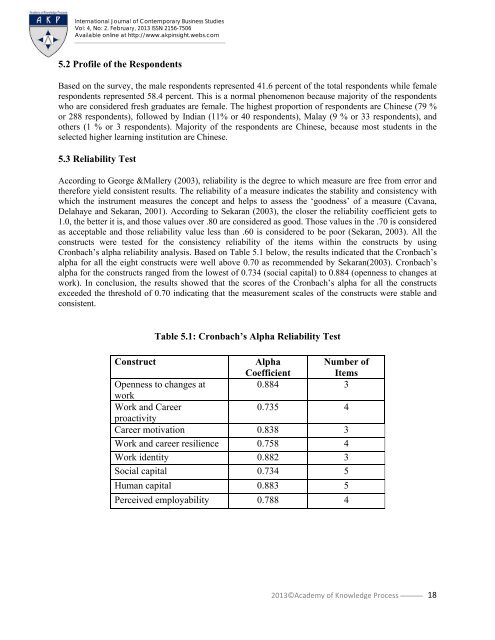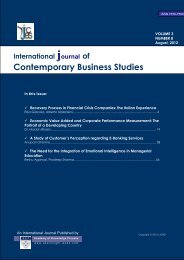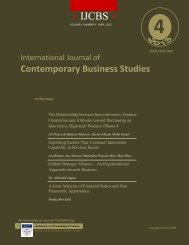Contemporary Business Studies - Academy of Knowledge Process ...
Contemporary Business Studies - Academy of Knowledge Process ...
Contemporary Business Studies - Academy of Knowledge Process ...
You also want an ePaper? Increase the reach of your titles
YUMPU automatically turns print PDFs into web optimized ePapers that Google loves.
International Journal <strong>of</strong> <strong>Contemporary</strong> <strong>Business</strong> <strong>Studies</strong>Vol: 4, No: 2. February, 2013 ISSN 2156-7506Available online at http://www.akpinsight.webs.com5.2 Pr<strong>of</strong>ile <strong>of</strong> the RespondentsBased on the survey, the male respondents represented 41.6 percent <strong>of</strong> the total respondents while femalerespondents represented 58.4 percent. This is a normal phenomenon because majority <strong>of</strong> the respondentswho are considered fresh graduates are female. The highest proportion <strong>of</strong> respondents are Chinese (79 %or 288 respondents), followed by Indian (11% or 40 respondents), Malay (9 % or 33 respondents), andothers (1 % or 3 respondents). Majority <strong>of</strong> the respondents are Chinese, because most students in theselected higher learning institution are Chinese.5.3 Reliability TestAccording to George &Mallery (2003), reliability is the degree to which measure are free from error andtherefore yield consistent results. The reliability <strong>of</strong> a measure indicates the stability and consistency withwhich the instrument measures the concept and helps to assess the ‘goodness’ <strong>of</strong> a measure (Cavana,Delahaye and Sekaran, 2001). According to Sekaran (2003), the closer the reliability coefficient gets to1.0, the better it is, and those values over .80 are considered as good. Those values in the .70 is consideredas acceptable and those reliability value less than .60 is considered to be poor (Sekaran, 2003). All theconstructs were tested for the consistency reliability <strong>of</strong> the items within the constructs by usingCronbach’s alpha reliability analysis. Based on Table 5.1 below, the results indicated that the Cronbach’salpha for all the eight constructs were well above 0.70 as recommended by Sekaran(2003). Cronbach’salpha for the constructs ranged from the lowest <strong>of</strong> 0.734 (social capital) to 0.884 (openness to changes atwork). In conclusion, the results showed that the scores <strong>of</strong> the Cronbach’s alpha for all the constructsexceeded the threshold <strong>of</strong> 0.70 indicating that the measurement scales <strong>of</strong> the constructs were stable andconsistent.Table 5.1: Cronbach’s Alpha Reliability TestConstructAlphaCoefficientNumber <strong>of</strong>ItemsOpenness to changes at0.884 3workWork and Career0.735 4proactivityCareer motivation 0.838 3Work and career resilience 0.758 4Work identity 0.882 3Social capital 0.734 5Human capital 0.883 5Perceived employability 0.788 42013©<strong>Academy</strong> <strong>of</strong> <strong>Knowledge</strong> <strong>Process</strong>18
















